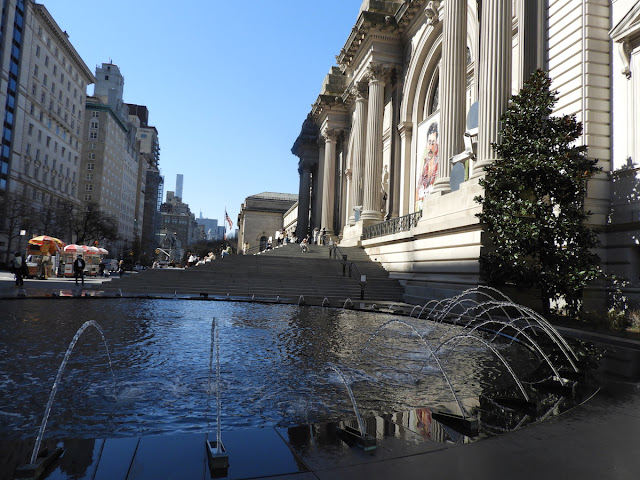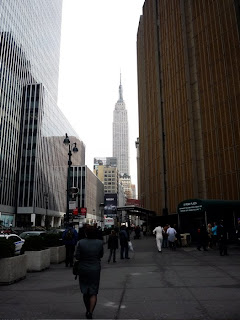Circling the Met: A Springtime Visit to Central Park and the Metropolitan Museum of Art
For a double feature of art and nature, the Metropolitan Museum of Art happens to be conveniently situated in Central Park. The front of the museum faces Fifth Avenue, its monumental wings stretching the blocks between E. 80th and E. 84th. The sides and the back of the museum are within easy walking distance of several prominent landmarks within the park.
 |
| Cedar Hill in Central Park |
Before a visit to the Met, consider taking a walk around the museum beginning on the southern side. A walk in the park can serve as a good preparation for a museum visit, because looking at or noticing the shapes and colors of the built and natural environment can enhance the art experience.
 | |
|
The path south of the 79 Street Transverse leads to a scene at Cedar Hill very much like a panorama, with a vast wide-angle expanse of green grass and hill. Take the first path that leads back over 79th Street to the southern side of the museum. This path brilliantly disguises the motor traffic below.
 |
| Greywacke Arch in Central Park |
Follow the curve along the rear of the museum and look for the Greywacke Arch. An ornate arch of Moorish influence, with a notable decorative cast-eon railing, the arch links the museum with the Great Lawn.
 |
| Obelisk (Cleopatra’s Needle) |
Go through the arch and bear right toward the Obelisk (Cleopatra’s Needle). Built circa 1450 BC, the obelisk is “the oldest manmade object in Central Park,” as noted on the Central Park Conservancy website.
 |
| A Red-Bellied Woodpecker investigates a tree near the Obelisk |
For a full appreciation of the park surroundings, including any nearby birds, walk up the steps to the raised Obelisk platform and have a look around.
 |
| Spring blossoms near the East Drive, Central Park |
Throughout this walk, frequent visitors to the museum may want to try a little game. While walking the exterior, match the architectural forms of the museum with the galleries inside, for example, the Robert Lehman Collection, the American Wing, and the Temple of Dendur. To study, a map is included here.
 |
| A path of the north side of the museum, looking toward Fifth Avenue |
Now, look for a gentle way to trample across the grass to reach the East Drive and then the walkway on the rear of the museum. Continue along the walk and then curve back to the right again on the northern side of the museum. Proceed in the direction of Fifth Avenue and then turn right to walk through the museum’s plaza and esplanade and up the famous steps of the museum.
 |
| The Metropolitan Museum of Art |
We’ve almost come full circle, but it’s time to visit the museum. But first, a word of note to fans of magnolia trees: While the tulip magnolia (or saucer magnolia) trees, the common name for the Liriodendron tulipifera, are in bloom at this time of year, the steps of the Metropolitan Museum of Art are flanked by two wonderful Magnolia grandiflora, the Southern magnolia.
 |
| One of the two Southern Magnolias that flank the museum steps |
For a long time, I never noticed them, but once during the summertime, as I was walking up the steps, I was suddenly hit with the lush smell of their giant blossoms and taken back to my Texas childhood.
 |
| The Great Hall, Metropolitan Museum of Art |
The Metropolitan Museum of Art, like other museums, has enacted full safety measures due to the pandemic. After a temperature check at the entrance, visitors will notice many signs for safe distancing and dispensers for hand sanitizer.
 |
| The Carroll and Milton Petrie European Sculpture Court |
For art lovers, the museums can provide an extraordinary opportunity to spend quality time alone with favorite paintings or galleries.
 |
| The waiting line for Alice Neel |
The exception to the relatively sparse crowds at the Met these days is the sensational show of work by Alice Neel (1900-1984). Born at the beginning of the twentieth century, during her life the longtime New York resident cast her gaze on the most central concerns of the century’s tumultuous decades, representing them mostly in vivid portraits of friends and strangers. Her urban landscapes of local scenes and the places where she lived are equally evocative of time and place. The waiting line to her exhibition may be deservedly long, but the line moves fast.
Images from Monday, April 5, 2021 by Walking Off the Big Apple.
Official websites:





Comments
Post a Comment